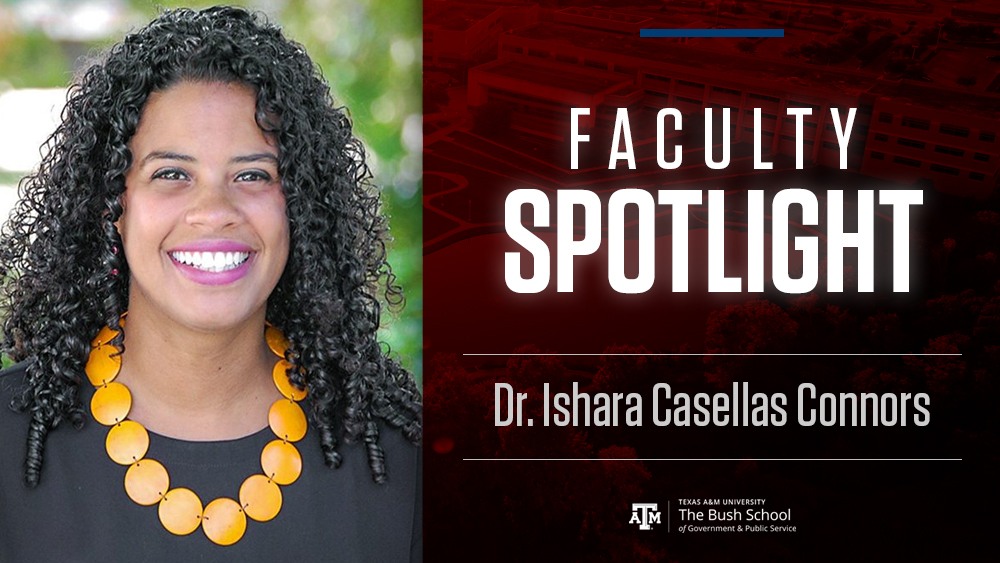
Dr. Ishara Casellas Connors joined the Bush School’s Department of Public Service and Administration in 2021. Dr. Casellas Connors has an extensive background in higher education administration and in diversity and equity policy.
Introduce yourself.
I’m Dr. Ishara Casellas Connors. This is my first year here at the Bush School. I teach a range of classes around education and education policy, as well as courses related to qualitative research.
What research projects are you currently working on?
I’m a higher education researcher, so my research really focuses on questions of state and institutional policy and their implications for higher education institutions. One area of my work is related to Hispanic-Serving Institutions and the ways in which state and institutional practice and policy implementation shape those institutions. The work that I’m most recently doing around diversity, equity and inclusion (DEI) implementation at Hispanic-Serving Institutions talks about the ways in which we need to empower stakeholders who are doing this work to use policy implementation as it relates to DEI topics, not just as a thing to check the box, but actually an opportunity to deeply reflect on the practices at their institution.
Another strand of my work is related to refugee access to higher education. How can state policy, and the institutions enrolling refugee students, provide the structures needed to support student access and success? Underpinning all of my research are questions related to equity and higher education. I’m interested in the ways in which institutions take up state policies, the ways in which they implement them and the implications for students.
What are you hoping to learn through your research?
I’m interested in Hispanic-Serving Institutions because they serve the largest number of LatinX students. There are about over 500 Hispanic-Serving Institutions nationally and over 200 “emerging” Hispanic-Serving Institutions. Those institutions are critical to our education for Latinx students. I’m interested in understanding is the ways in which these institutions take up DEI policy and the implications for Latinx students.
When it comes to refugee education, particularly in this current moment as we think about the tens of thousands of Afghan refugees that have come here to the U.S., thinking about the ways in which we can support refugee access to higher education has become increasingly critical.
In a given year, we have nearly 17 million students enrolled in higher education. How those students are served by those institutions really matters to their successful outcomes going forward.
What do you like most about working at the Bush School?
I love my classes because I really enjoy engaging with students. I find that the students here are really interested in learning new topics and engaging in deep, critical reflections of the research. That’s very interesting and exciting. The other piece I really like about the Bush School is that we have a really diverse group of faculty who bring a lot of different perspectives and experiences, and for me that’s really important for thinking about this work.
Have you ever worked outside of academia, and how does that inform your research or teaching?
I did fundraising and alumni relations at several higher education institutions before transitioning to work around policy and research. Following my work in alumni relations, I did work for a community college association as well as an advocacy organization related to education access. In those roles I sought to bridge research and practice and figure out how we can better support students across a host of different kind of statewide contexts. I then moved on to doing work around civic and political learning in higher education at the Institute for Democracy and Higher Education. Most recently I was here at Texas A&M as the Assistant Dean for Diversity and Climate in the College of Geosciences. That experience really grounds some of my work around DEI research. I see that trajectory and suite of professional roles as informing the research that I undertake, the questions that I’m interested in, and the framing that I bring to the work. Most importantly, I really see that work as important to how I think about the implications: how do I use my research to inform practice within higher education and within state policy?
What research or teaching accomplishment are you most proud of and why?
I am committed to research examining Hispanic Serving Institutions. I am proud of research I have done in this space that includes institutions that often have gone overlooked in the HSI conversation. This research includes institutions in Florida and New York to expand our thinking about HSIs. I also wrapped up a project exploring how institutions support refugee students. Engaging with practitioners to help them critically reflect on what they have done and what they could do. Going forward, supporting more participatory research projects is something that’s important to me.
What is your favorite class to teach and why?
I enjoy teaching qualitative methods in part because I think it forces students to think a little bit differently about how we can construct research. How do we bring people’s voices to the conversation? How do we elevate and empower the voices of folks that may not be heard in these conversations to be the focal point of research? Students come into the class saying, “I don’t know how to do qualitative research. I’ve never done this.” I like reminding them that they’ve done it in some way – allowing folks to leverage their unique skills and experiences. Maybe it’s experience interviewing folks for a newspaper or working to understand a needs assessment for an organization. What our class allows them to do is understand a systematic and rigorous process for qualitative research. For me that’s really fun — allowing them to see how they can use that in their professional world going forward.
